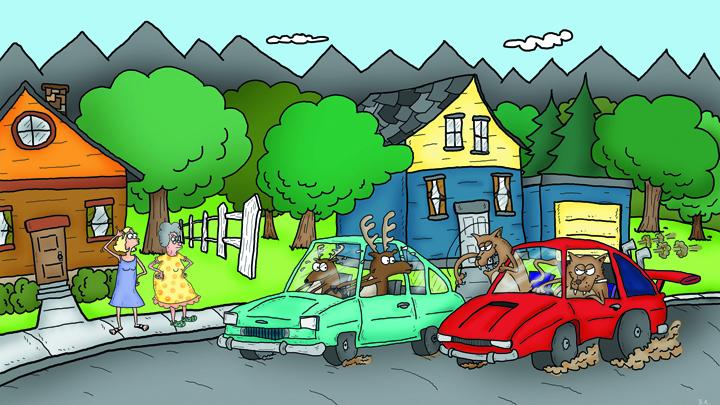Our New Urban Settlers: Ungulate Invaders in Bozeman
In the summer, my 86-year-old mother’s year-round battle with urbanized deer reaches its peak. Deer are very fond of some of her favorite plants: snow peas, lettuce, hybrid roses. She’s rigged a tall fence around a space in the center of what used to be her huge vegetable garden. Each year, more and more apparently delicious flowers move into the fortress. But this winter the deer set new records. Almost every day my mother left a new report on my answering machine. “I counted 25 today,” she’d say, her frustration evident.
My mother thinks they’re beautiful animals. But as a gardener, she can’t quite forgive their depredations. This winter they ate things they’d never even nibbled on before, like the 38-year-old Japanese yew that grows under the eaves of the house.
In March she left this message: “You’ll never guess what the deer have done now. One of them is lying dead right by the downstairs bedroom window.”
“What are you going to do with a dead deer?” I asked.
“Oh, I called the wildlife people,” she said. “They’ll send a ranger out.”
So the next morning I met Ranger Joe Knaar at the foot of my mother’s south deck. We gathered around the body of the small buck. “So what killed it?” I asked.
“I’m going to have the veterinarian look at it—I’m worried about these legs,” Joe said. He pointed at the deer’s ankles and wrists, which were badly abraded. “I want to be sure it isn’t some sort of wasting disease.”
When a dead deer is found on private property, Joe usually tells people to dispose of the corpse themselves, but because this one involved a possibly helpless little old lady, he’d come to deal with it. He dragged the dead deer across the lawn toward his truck, where his dog whined with excitement.
A few weeks later I called for the autopsy results. “The vet says that deer died of a parasite disease.” Joe said. “In essence it starved. The leg injuries were probably caused by pawing through crusted snow.”
My mother received the news with some sadness, worrying that the deer’s last hours had probably been painful. She’d preferred to imagine a deer going happily to sleep with its tummy full of her Japanese yew.
As it turns out, its tummy probably was full, according to Craig Jourdonnais, a wildlife biologist with the Montana Department of Fish, Wildlife and Parks. “They often have full stomachs when they starve,” he told me. “They’re just not able to get enough nourishment from what they’ve eaten.”
“It comes down to the micro-organisms in their stomach that help them digest what they eat,” he says, adding that early spring is particularly challenging for deer. “It’s a difficult transition for their systems, going from the dry brown grass they’ve been eating to green fresh grass with so much water in it.”
Craig says that the past winter was particularly hard on deer. We had very heavy snows early on, then some melting weather, followed by extreme cold, which meant that all the snow was heavily crusted. It’s not surprising that deer drift into town searching for something to eat.
“As soon as winter let go of us, the deer started to disperse,” Craig points out. “Town’s not where they want to be. As soon as the snow is off, they begin to seek out better forage.”
As for whether the deer population is exploding, Craig points out, “Seeing more deer around our houses doesn’t mean there’s been a huge population increase.” People are building more and more housing in areas where the deer and antelope used to play unobserved. The deer are simply coping with us. “You can’t ignore how fast people are carving up this valley,” Craig says. “And the whitetail deer are very adaptable with their wide range of diet.”
Although Craig realizes that the increased deer presence in neighborhoods is a big deal for gardeners like my mother, he says there is one thing that worries him a lot more: deer are prey. “Mountain lions will come into town, too,” he says, “because their favorite food is now living in town, and because the young cats need to carve out their own territories.”
And that’s when it starts to get interesting. Last fall a mountain lion and a domestic cat were found dead in a driveway only a mile or two beyond my mother’s place, both electrocuted when the lion chased the cat up a power pole and they completed a circuit between two wires.
The deer problem is not unique to Bozeman. “We get these complaints from all over,” Craig says. “Missoula, Billings, Fort Benton, Glasgow. They’re having a terrible time maintaining the flower beds around the Capitol in Helena.”






